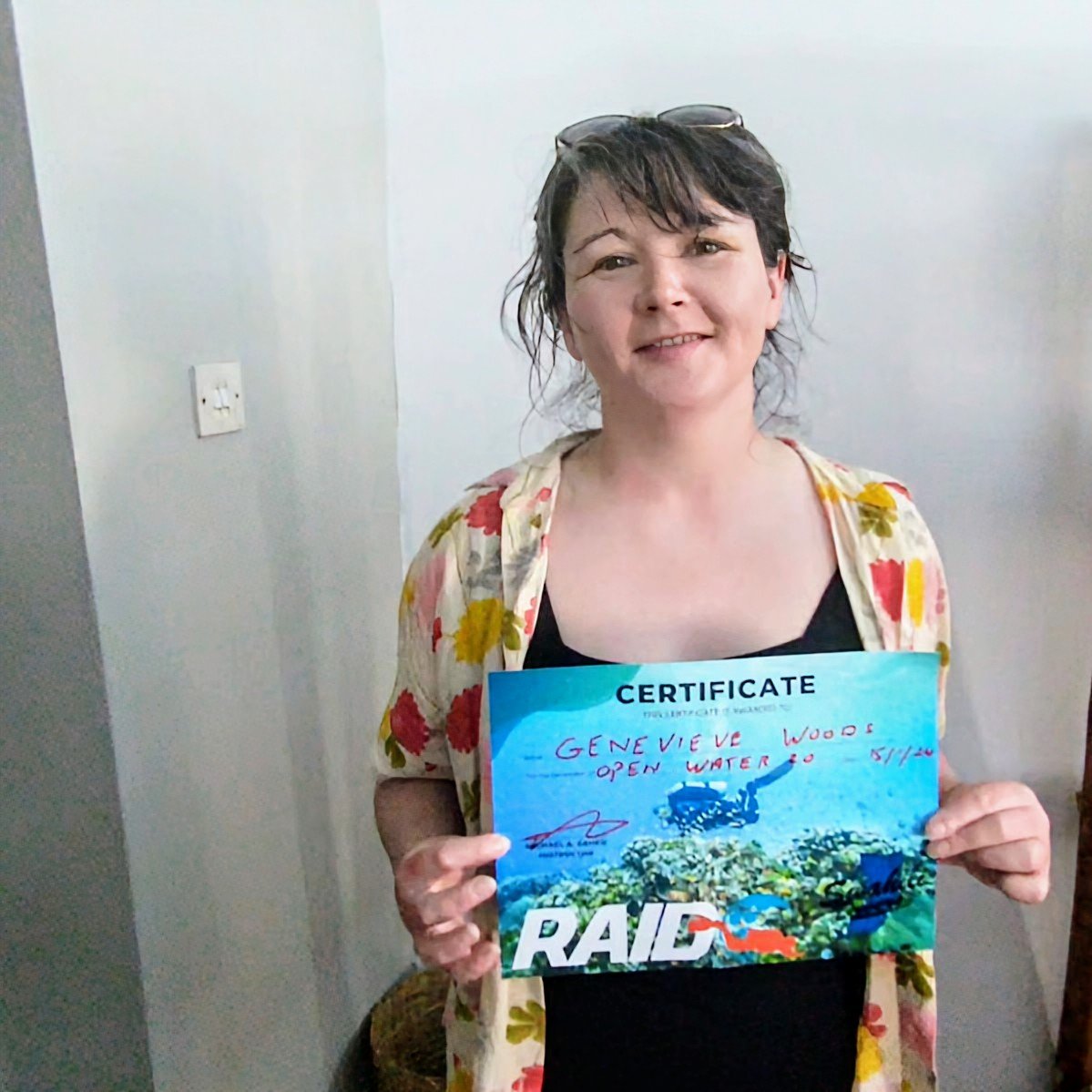Complete Wetsuit Thickness Guide (includes a Wetsuit Thickness Chart)
Throughout four decades of diving experience, one lesson stands out: the right wetsuit thickness makes or breaks your dive. It impacts comfort, safety, and your overall performance underwater.
Unfortunately, choosing the correct thickness can seem daunting, especially for beginner scuba divers.
This comprehensive wetsuit thickness and temperature guide will equip you with the knowledge to make an informed decision when picking your ideal wetsuit, regardless of your experience level.
Wetsuit Thickness Explained
Understanding the Numbers: Wetsuit markings – like 3/2mm or 5/4/3mm – indicate neoprene thickness in millimeters across different body parts. The higher the number, the thicker the material in that area.
The first number represents your core, and the second your arms and legs.
Typical Ranges: Wetsuits range from thin 1mm rash guards to beefy 7mm+ suits built for the most frigid conditions. Most recreational divers fall in the 2mm to 5mm range.
Full Suits vs. Shorties: Full suits cover your core, arms, and legs. Shorty wetsuits (or "spring suits") have short sleeves/legs and are ideal for warmer waters.
Why Thickness Matters: Insulation
This design isn't just about style. Your core generates more heat and is more susceptible to heat loss, needing greater insulation. Even a few millimeters can drastically impact comfort for those who run cold easily. This is one of the safety concerns of scuba diving to watch out for.
Neoprene traps a thin layer of water next to your skin, which your body warms. Thicker neoprene means more insulation, preserving this warmth and preventing core heat loss.
Thinner arms and legs ensure flexibility for swimming, paddling, and other essential underwater movements. Essentially, thicker wetsuits are designed to retain more warmth.
The key to choosing the right thickness lies primarily in one factor: water temperature.
Please note: Body composition plays a huge role in warmth underwater. As a 5 ft 4, let's just say "well-insulated" diver, here are my wetsuit choices:
Tropical Waters: Don't be fooled by the warm air! Even in 27°C+ water, I prefer a 3/2mm full suit for multi-dive days. That "little bit" of extra thickness prevents me from getting gradually chilled across several dives.
Temperate and Beyond: My go-to is a solid 5/4/3mm, though I do have a 7mm semi-dry for colder expeditions. Fit becomes even more important as I have a non-standard. It took me years to find brands that fit properly.
Wetsuit Thickness Chart & Water Temperature Guide
Let's break things down clearly. I've created a reference chart outlining recommended thicknesses based on water temperatures and different dive types. Remember, personal preferences and dive locations create some variability, so use this as your expert starting point:
Wetsuit Thickness Chart
| Temperature Range (°F/°C) | Recommended Wetsuit Thickness Options | Activity Notes | Example Dive Locations |
|---|---|---|---|
| 80°F+/ 27°C+ | Rash guard, Lycra shirt, Shorty wetsuit (1-2mm) | Best for very warm surface activities or if you easily overheat | Maldives, Caribbean, Great Barrier Reef (summer) |
| 72-79°F / 22-26°C | 2mm - 3/2mm fullsuit | Versatile range, surfing focus may lean thinner | Florida Keys, Mediterranean (summer), Southern California |
| 65-71°F / 18-22°C | 3/2mm - 5/4/3mm fullsuit | Standard for temperate diving, thickness depending on individual preference | Northern California, UK (summer), South Africa (summer) |
| 57-64°F / 14-18°C | 5/4/3mm - 6.5mm fullsuit, hood | Colder water calls for thicker suits, divers might opt for 7mm | Great Lakes (summer), Oregon Coast, Tasmania |
| 50-56°F / 10-13°C | 6.5mm, 7mm fullsuit, hood, booties, possibly gloves | Significant warmth needed, some might consider drysuits | Iceland, Northern Norway, Patagonia |
| Below 50°F / 10°C | 7mm+ fullsuit, hood, booties, gloves, OR drysuit | Extreme cold-water diving, specialists only | Antarctica, Winter diving in high-latitude regions |
How to Use This Chart
Find the average temperature range for your dive site. There are plenty of resources online for researching this.
Start with the primary recommended thickness, factoring in activity. Surfers might opt for slightly thinner options compared to divers at the same temperature.
Adjust based on your sensitivity to cold. If you're like me and get cold easily, add a millimeter or consider layering options.
The Perfect Wetsuit Thickness – It Doesn't Exist!
Here's the truth many guides won't tell you: there's no standardized "average" body and cold tolerance when it comes to diving. That's why the chart is a starting point, not a universal truth. Factors impacting your warmth needs include:
Body Fat Percentage: More natural insulation means you might be fine with a slightly thinner wetsuit than someone leaner.
Metabolism: People who run cold naturally might need to go a bit thicker compared to those who are always toasty on land.
Blood Circulation: Conditions affecting circulation can impact how quickly your extremities get cold.
Experience: Seasoned divers acclimate somewhat to colder water, but it's never a reason to skimp on necessary thickness.
Shopping for and Renting Wetsuits
Wetsuits are arguably the most essential dive equipment. Here’s where to look…
Dive Shops: Their expertise is invaluable, especially when figuring out fit! Trying on various brands and thicknesses lets you find the best option for your body and budget. This is especially important for those of us with less common builds.
Renting: Start Here: This is a brilliant way to experiment when you're new to diving, or if you predominantly dive in warm locations and occasionally venture into colder water.
Online: Know the Risks: If you have standard sizing and prior experience, online stores can offer deals. But if it's your first suit, or you've never tried on the brand before, the risk of poor fit is real.
Dive Center Advantage: Some dive centers also offer dive wetsuit rentals. You can find a great suit that meets your exact needs, and the real advantage is that you’re accompanied by experts who’ll help you make the pick, especially if you’re a beginner.
Make sure you get dive-certified before you go try out the wetsuit.
Tailoring Your Choice: Wetsuit Thickness by Activity
While water temperature is the primary guide, the type of water-based activity you'll be participating in also plays a role:
Scuba Diving Wetsuit Thickness Guide:
When you're scuba diving, say in the Maldives, in Zanzibar, or on Pemba Island, warmth is paramount. Extended time underwater means greater potential for core heat loss, even in seemingly warm water.
A wetsuit isn't just about comfort – it's about preventing that gradual chill that cuts your dive short and distracts you from the incredible marine life. Remember, even on multiple dives in tropical waters, a bit of thickness (like a good 3/2mm) makes a world of difference.
Surfing Wetsuit Thickness Guide
Surfers face a delicate balance. Too thick a wetsuit and your paddling becomes a laborious chore, costing you precious wave-catching energy. The sacrifice is a bit of warmth, but the ability to move powerfully is vital.
Many surfers opt for thinner suits in the torso and legs than a diver might wear at the same temperature. Look for wetsuits with flexible panels in the shoulders and arms for maximum mobility.
Triathlon Wetsuit Thickness
Triathlon wetsuits are a whole different beast! First off, temperature regulations at your event are the law. These suits are designed to be sleek and easy to remove during that whirlwind transition.
Warmth is secondary, though not ignored, especially in colder water events. Always check the rules and invest in a suit specifically built for this unique sport."
Freediving:
Movement is king, so thinner suits are common. But longer dives might necessitate some neoprene, even in warmer waters.
Spearfishing:
This depends heavily on how long you're in the water, the temperature, and how still you are while hunting.
More Essential Wetsuit Considerations
These additional factors maximize warmth and overall dive comfort. They’re extremely important:
Wetsuit Fit: The Key to Warmth
I could talk about fit for days! A baggy wetsuit, even if it's the thickest on the rack, will leave you shivering. It should be snug like a second skin but never restrict breathing or movement.
Water constantly flushing in and out defeats the whole purpose! If you're between sizes, consider sizing down if you have less body fat, and size up if you have more. This is where a dive shop's fitting expertise is invaluable."
Accessories for Cold Water
When things get chilly, it's time for reinforcements:
Hoods: Prevent major heat loss from your head, a surprising culprit in colder water. Thickness matters here too!
Booties: Numb toes are a miserable distraction. Find booties that fit well under your fins.
Gloves: Less common than the above, but in truly frigid conditions, they're lifesavers. Dexterity suffers though, so factor that in.
Layering for Extra Warmth
Sometimes, you need a boost without buying a whole new suit. Here's what works:
Rashguards: Thin and flexible, adding one under your wetsuit provides surprising insulation.
Neoprene Vests: These give targeted torso warmth – great for those who get cold easily. See, that’s why picking the right wetsuit is essential for your dive safety.
Wetsuit Thickness FAQs
Let's tackle some frequently asked questions to empower your wetsuit decisions:
What wetsuit thickness do I need?
Consult the chart, consider your intended dive location's water temperatures, and factor in your sensitivity to cold. Err on the warmer side if you tend to feel chilled quicker than others.
My cold tolerance doesn't align with the chart, what do I do?
Remember, this is a guidepost, not a rigid rule. If you have previous experience, use that knowledge to adjust accordingly. Renting wetsuits initially can help establish your baseline comfort level.
What's a good beginner wetsuit thickness?
A 3/2mm offers a versatile balance of warmth and flexibility, making it a great starting point.
What's the warmest possible wetsuit?
Wetsuits range up to 7mm and occasionally beyond. These are built for extreme cold-water diving. A drysuit becomes a more practical solution for most divers beyond a certain thickness.
Conclusion
Selecting the optimal wetsuit thickness is an investment in an enjoyable and successful dive experience. With this knowledge, you can focus on the wonders of the underwater world, rather than the discomfort caused by improper protection.
Looking for new dive locations this year? How about you try some of Africa’s most pristine dive locations with unimaginably diverse marine life. Pemba Island, Zanzibar, for example, has one of the largest coral reef systems in the world. Talk to us, to learn more about planning a dive trip to Zanzibar.

"We enjoyed some wonderful dives with Swahili Divers during our holidays in Pemba this July/August. Mike and the team are very professional, and always ready to support and find solutions. The dive sites are very diverse and can be used for junior open water divers up to very experienced ones. That means shallow water to super nice wall dives. Thanks for the wonderful time with you!! "
Regards, Nicole & Patrick and the 3 kids;-)

"I came to Pemba to see the coral. It was beautiful, in good condition, and full of fish and nudibranchs. The diving staff of Swahili divers are all excellent. Equipment was all included and was spot-on. My partner completed her Open Water certification in a few days and we were both totally satisfied."
Evo S.


